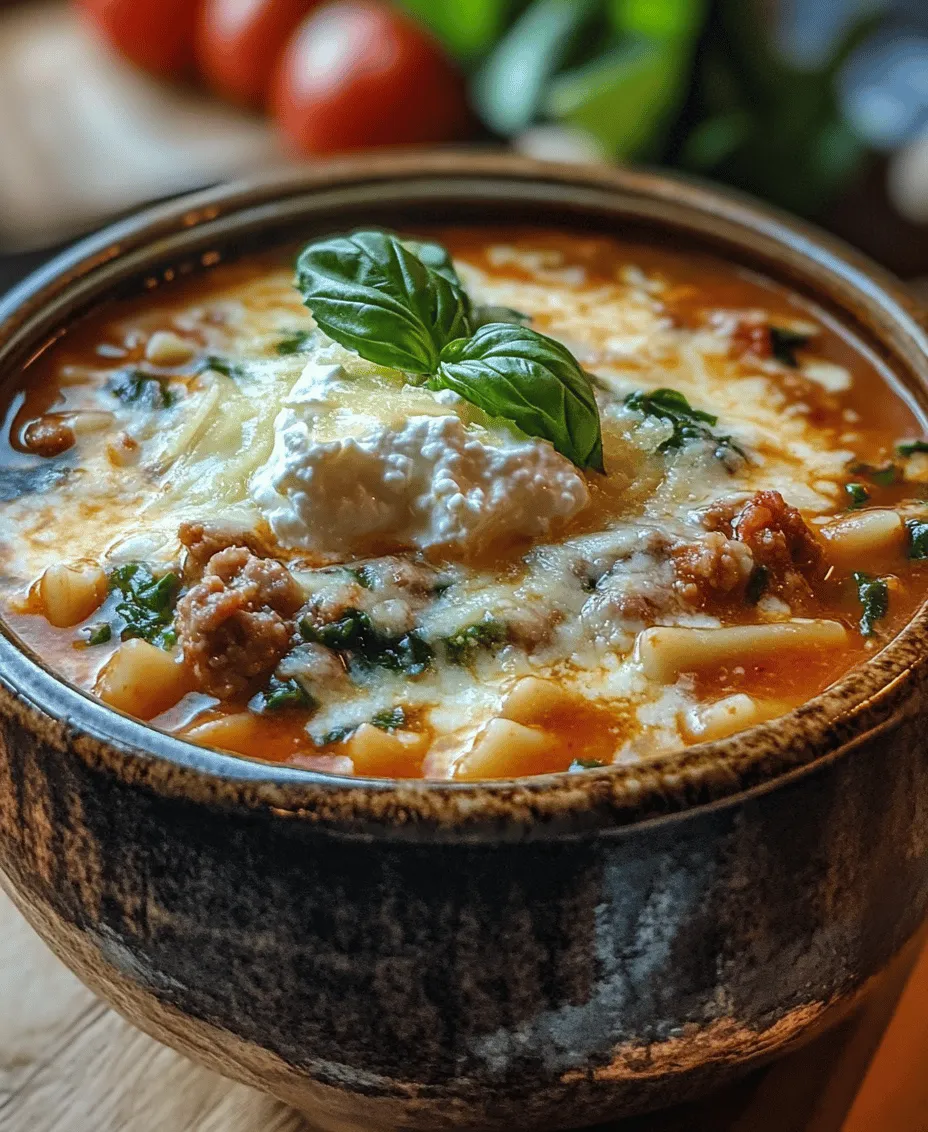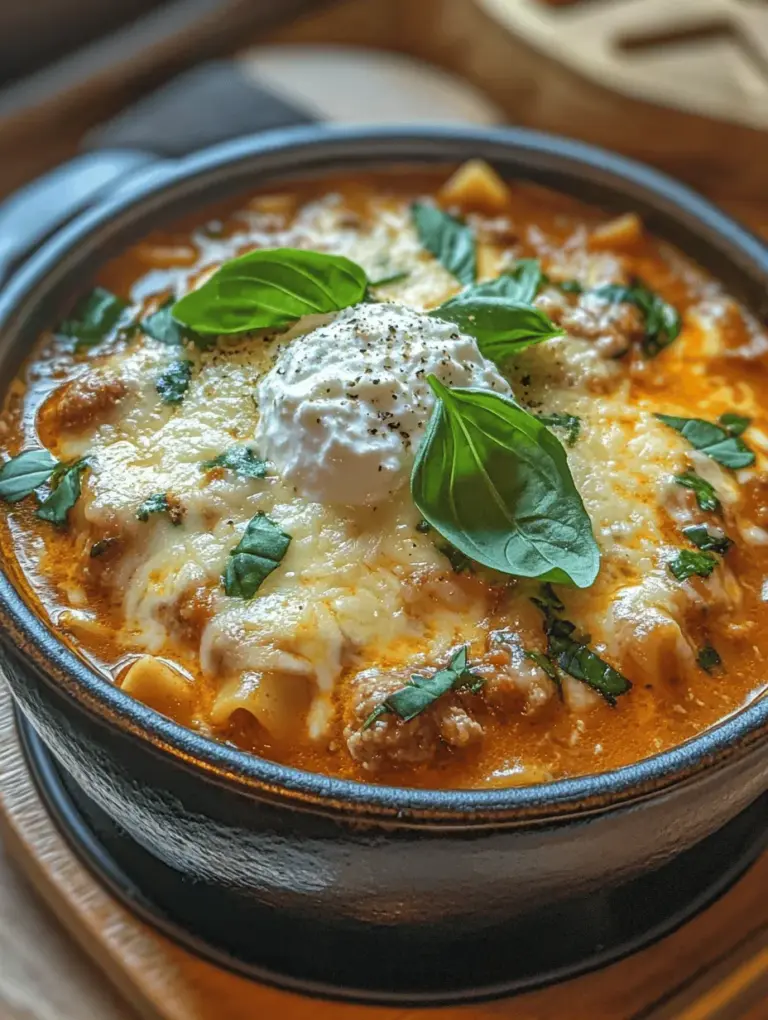Introduction
Lasagna soup has recently surged in popularity, capturing the hearts and appetites of home cooks everywhere. This delightful dish combines the comforting essence of traditional lasagna with the ease and warmth of a hearty soup, making it perfect for any occasion. Imagine a bowl filled with rich flavors, tender noodles, and a creamy topping, all served piping hot. It’s no wonder that lasagna soup has become a go-to meal for busy weeknights and cozy family dinners alike.
Comfort food, by definition, is meant to provide solace and satisfaction, embodying warmth, flavor, and nostalgia in every bite. Lasagna soup does just that, evoking memories of family gatherings around the dining table while also offering a modern twist that appeals to contemporary tastes. Whether you’re curling up on the couch after a long day or hosting a gathering with friends, this dish is sure to create a sense of togetherness and joy.
In this article, we will explore the recipe for the BEST lasagna soup, showcasing its simplicity and deliciousness. With a few key ingredients and straightforward steps, you’ll soon find yourself serving a warm, satisfying meal that rivals its traditional counterpart.
Understanding Lasagna Soup
So, what exactly is lasagna soup? At its core, lasagna soup is a deconstructed version of the classic Italian dish lasagna, transforming its layered components into a single, comforting bowl of deliciousness. This innovative approach maintains the essence of lasagna while simplifying the cooking process.
One of the primary benefits of lasagna soup is its quick cooking time. Unlike traditional lasagna, which can take hours to prepare and bake, lasagna soup can be ready in under an hour. This makes it an ideal choice for busy weeknights when time is of the essence, yet you still want to serve a meal that feels special. Furthermore, the soup format allows for easier serving, as you can simply ladle it into bowls rather than dealing with layers of pasta and cheese.
From a nutritional standpoint, lasagna soup can also offer some advantages over its baked counterpart. While both dishes can be rich in calories, lasagna soup allows for more control over portion sizes. You can easily customize the ingredients to include more vegetables or lean proteins, making it a versatile option for families with varying dietary preferences. Additionally, the broth-based nature of the soup can help increase hydration, making it a comforting choice during colder months.
Key Ingredients in Lasagna Soup
The taste and texture of lasagna soup come from a harmonious blend of key ingredients. Each component plays a vital role in creating a dish that is both satisfying and delicious.
Italian Sausage
Italian sausage serves as the flavor foundation for lasagna soup, providing a robust and savory taste. Depending on your preference, you can choose between mild or spicy sausage, or even substitute it with ground turkey or chicken for a lighter option. The sausage not only adds depth but also acts as a primary protein source, ensuring that the soup is hearty and filling.
Onions and Garlic
Onions and garlic are staples in many culinary traditions, and they are no exception in lasagna soup. These aromatics create a flavorful base that enhances the overall taste of the dish. Sautéing them until they are soft and fragrant releases their natural sweetness, which balances the acidity of the tomatoes and enriches the soup with layers of flavor.
Tomatoes
Tomatoes are the heart and soul of lasagna soup. They provide the necessary acidity and richness that characterize both lasagna and its soup variant. You can use crushed tomatoes, diced tomatoes, or even tomato sauce, depending on your desired consistency and flavor profile. The tomatoes not only contribute to the soup’s rich color but also pack it with essential nutrients like vitamin C and antioxidants.
Broth
Broth is the lifeblood of any soup, adding moisture and enhancing the overall body of the dish. For lasagna soup, chicken, vegetable, or beef broth works well, depending on your flavor preference. The broth ties all the ingredients together, creating a cohesive and comforting liquid that envelops the pasta and veggies.
Lasagna Noodles
The signature element of lasagna soup is, of course, the lasagna noodles. These wide, flat pasta sheets capture the essence of traditional lasagna while absorbing the flavorful broth. You can break the noodles into smaller pieces or use no-boil noodles for added convenience. This way, you still get the delightful texture of lasagna in every spoonful.
Spinach
Adding spinach to lasagna soup not only boosts its nutritional value but also enhances its visual appeal. This leafy green brings a pop of color and additional texture, making the soup feel more vibrant and wholesome. Spinach is rich in vitamins, minerals, and antioxidants, adding a healthful dimension to your meal without overwhelming the classic flavors.
Cheese Mixture
Finally, no lasagna is complete without cheese, and lasagna soup is no exception. The creamy cheese mixture typically includes ricotta, mozzarella, and Parmesan, providing that decadent, gooey topping that elevates the dish to new heights. When dolloped on top of the hot soup, the cheese melts slightly, creating a luscious, comforting finish that will leave you craving more.
Preparation Steps for the BEST Lasagna Soup
Now that we have a solid understanding of the key ingredients, let’s dive into the preparation steps for the BEST lasagna soup. This straightforward process ensures that you can enjoy a delicious meal without spending all evening in the kitchen.
Sautéing the Sausage
The first step in creating this flavorful soup is to sauté the Italian sausage. Begin by heating a large pot or Dutch oven over medium heat. Add the sausage, breaking it up with a wooden spoon as it cooks. The goal is to brown the sausage until it is fully cooked and caramelized on the outside. This browning process is crucial, as it develops a depth of flavor that will permeate the entire soup.
As the sausage cooks, be sure to drain any excess fat if necessary. While a bit of fat can add richness, too much can make the soup greasy. Once the sausage is cooked through, remove it from the pot and set it aside, leaving behind any flavorful drippings.
Adding Aromatics
With the sausage removed, it’s time to build upon that delicious base. Lower the heat slightly and add diced onions to the same pot. Sauté the onions for about 3-4 minutes, or until they become translucent and tender. Next, add minced garlic, cooking for an additional minute until fragrant. This aromatic duo—onions and garlic—will provide an incredible depth of flavor that is essential for the overall taste of the soup.
Once the onions and garlic are sautéed to perfection, you can return the cooked sausage to the pot. Stir to combine, allowing the flavors to meld for a minute or two before proceeding to the next steps.
This combination of sautéed sausage, onions, and garlic creates a rich and savory base for your lasagna soup, setting the stage for the addition of the remaining ingredients. As you continue with the recipe, you’ll build layers of flavor that will culminate in a bowl of hearty, satisfying soup perfect for any occasion.
Stay tuned for the next part of this article, where we will continue with the steps to complete the BEST lasagna soup, along with helpful tips to ensure your dish turns out perfectly every time.

Incorporating Tomatoes and Broth: Achieving the Desired Soup Consistency
To create the perfect lasagna soup, the key lies in achieving the right balance of flavors and textures, starting with the incorporation of tomatoes and broth. Begin by adding crushed tomatoes to the pot, which will provide a rich, tangy base. Using canned tomatoes can save time, but for a fresher flavor, consider roasting whole tomatoes beforehand. This step adds a depth of flavor that elevates the soup.
Next, pour in the chicken or vegetable broth, depending on your preference. For a heartier soup, opt for low-sodium broth to control salt levels while allowing the natural flavors to shine. Stir the mixture well and bring it to a gentle simmer. Adjust the consistency by adding more broth or a splash of water if it becomes too thick. The goal is to create a comforting, hearty soup that retains the essence of lasagna without being overly watery or too dense.
Cooking the Noodles: Tips for Timing to Ensure Perfect Texture
Cooking the noodles is a crucial step in ensuring that your lasagna soup has the right texture. Traditional lasagna noodles can take a while to soften, so it’s essential to add them at the right time during the cooking process. Break the noodles into smaller pieces, about 1 to 2 inches long, to mimic the layers of lasagna.
Once the soup has reached a simmer, add the broken noodles. Most lasagna noodles require around 8 to 10 minutes of cooking time, but keep a close eye on them. Stirring occasionally will help prevent the noodles from sticking together and ensure even cooking. Taste a noodle after about 5 minutes to gauge their doneness; they should be al dente, meaning they still have a slight bite to them. This texture is vital as the noodles will continue to absorb liquid and soften slightly after being removed from heat.
Adding Spinach: Maintaining Its Vibrant Color and Nutrients
To incorporate vegetables and add a pop of color, fresh spinach is an excellent choice. Adding it towards the end of the cooking process helps maintain its vibrant green color and nutrients. Simply stir in a couple of handfuls of fresh spinach once the noodles are cooked.
Allow the spinach to wilt for just a minute or two, stirring gently to combine. Overcooking spinach can lead to a dull color and loss of nutrients. The residual heat from the soup will effectively cook the spinach without compromising its health benefits. This addition not only enhances the nutritional profile of your lasagna soup but also introduces a lovely freshness that brightens each bowl.
Preparing the Cheese Topping: Balancing Flavors and Textures
No lasagna soup is complete without a creamy, cheesy topping that complements the rich flavors below. To prepare the cheese topping, combine ricotta cheese, grated Parmesan, and shredded mozzarella in a mixing bowl. This blend creates a luxurious texture and a flavor profile reminiscent of traditional lasagna.
For added depth, consider mixing in a pinch of Italian seasoning, a dash of garlic powder, or a drizzle of olive oil for extra richness. The cheese should be creamy yet sturdy enough to hold its shape when dolloped on top of the soup.
Once your soup is ready to serve, spoon a generous amount of the cheese mixture into each bowl. As the cheese melts slightly from the heat of the soup, it will create a delightful contrast between the warm soup and the rich, creamy topping.
Serving Suggestions for Optimal Enjoyment
Presentation Tips for Serving Lasagna Soup
Presentation is key to making your lasagna soup not only delicious but visually appealing as well. Serve the soup in deep, rustic bowls to enhance the hearty nature of the dish. For an elegant touch, consider layering the cheese topping in a small ramekin and placing it in the center of the bowl before adding the soup. This method creates a beautiful focal point while keeping the cheese intact.
A sprinkle of freshly grated Parmesan and a drizzle of olive oil just before serving can elevate the visual appeal even further. Don’t forget to use contrasting colors to make the dish pop, such as the bright green of basil or parsley against the rich red of the soup.
Pairing Ideas: What to Serve Alongside the Soup
Lasagna soup pairs wonderfully with various sides that complement its flavors. A warm, crusty bread, such as a baguette or garlic bread, is perfect for dipping and soaking up the delicious broth. If you’re in the mood for something lighter, a simple green salad with a lemon vinaigrette can provide a refreshing contrast.
Consider a Caesar salad or a Caprese salad for a more Italian flair. Both options enhance the overall dining experience without overshadowing the main dish.
Ideas for Garnishing: Fresh Basil and Other Herbs for Added Aroma and Visual Appeal
Garnishing your lasagna soup can elevate it from a simple meal to a visually stunning dish. Fresh basil is a classic choice that adds both aroma and a burst of flavor. You can either tear the leaves by hand or slice them into thin strips for an elegant finish.
Other herbs, such as parsley or oregano, can also be used for garnishing, adding additional layers of flavor. A sprinkle of red pepper flakes can provide a hint of heat for those who enjoy a spicy kick. Finally, a few shavings of Parmesan cheese on top not only looks appealing but also enhances the cheesy goodness of the dish.
Variations and Adaptations
Suggestions for Customizing the Recipe Based on Dietary Preferences
One of the best aspects of lasagna soup is its versatility. You can easily customize the recipe to meet various dietary preferences and restrictions. For a healthier version, consider using whole grain or vegetable-based lasagna noodles, which can add fiber and nutrients to your meal.
Vegetarian Options: Substituting Sausage with Plant-Based Alternatives
For those following a vegetarian diet, simply substitute the sausage with plant-based protein options. Crumbled tempeh, lentils, or chickpeas can provide a hearty texture while absorbing the rich flavors of the broth. Additionally, you can enhance the soup with extra vegetables such as mushrooms or eggplant, which add both flavor and substance.
Gluten-Free Adaptations: Using Gluten-Free Lasagna Noodles
If you’re looking for gluten-free options, many brands offer gluten-free lasagna noodles made from rice or corn. These alternatives perform similarly to traditional noodles and can be incorporated seamlessly into your lasagna soup. Be mindful of the cooking times, as gluten-free noodles may require different cooking durations than standard noodles.
Adding Vegetables: Incorporating Zucchini, Bell Peppers, or Mushrooms for Extra Nutrition
Incorporating more vegetables into your lasagna soup not only boosts its nutritional value but also enhances the flavor profile. Zucchini, bell peppers, and mushrooms can add an earthy sweetness and texture. Simply chop these vegetables and sauté them with the onion and garlic at the beginning of your cooking process.
Spice Levels: Adjusting Seasoning to Cater to Different Palates
The spice level of your lasagna soup can be easily adjusted to cater to different tastes. If you prefer a milder flavor, reduce the amount of Italian seasoning or omit the red pepper flakes. Conversely, for those who enjoy a kick, feel free to add more red pepper flakes or even a splash of hot sauce.
Nutritional Information
Overview of the Nutritional Benefits of Lasagna Soup
Lasagna soup is a comforting dish that can also be quite nutritious. By incorporating lean proteins, vegetables, and wholesome noodles, this recipe offers a well-rounded meal. The tomatoes provide antioxidants, while the spinach is rich in vitamins A and C.
Comparison of Calorie Count and Macronutrients with Traditional Lasagna
When compared to traditional lasagna, lasagna soup often has fewer calories and carbohydrates, making it a healthier option. Each serving of this soup can be tailored to fit your dietary needs, whether you’re looking for lower carbs or higher protein.
Highlighting the Use of Fresh Ingredients and Their Health Benefits
Using fresh ingredients is not only better for flavor but also for overall health. Fresh vegetables and herbs are packed with nutrients and can help support a balanced diet. Opting for low-fat dairy products can also reduce calorie intake while still providing the creamy texture that enhances the soup.
Conclusion
Lasagna soup is a delightful twist on a classic dish, providing all the comforting flavors of lasagna in a simple and satisfying soup form. The ease of preparation, coupled with the ability to customize the recipe, makes it a perfect choice for busy weeknights or cozy gatherings with loved ones.
Don’t hesitate to experiment with different ingredients and flavors to truly make this recipe your own. The joy of cooking lies in creativity, and sharing a warm bowl of lasagna soup with family and friends is a rewarding experience that brings everyone together. Enjoy the process, savor the results, and relish the comfort of this beloved dish.

